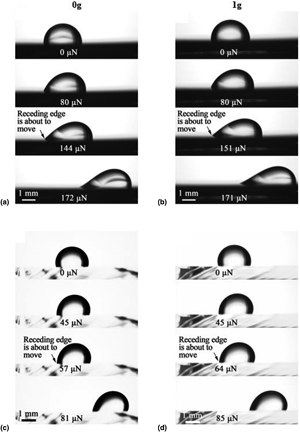Article contents
Lateral retention of water droplets on solid surfaces without gravitational effect
Published online by Cambridge University Press: 05 June 2020
Abstract

Gravity is commonly considered negligible when the surface tension is dominant; i.e., the Bond number is less than 1. In this paper, however, the authors present a technique in which drops slide over surfaces with zero effective gravity. Our study compared the sliding motion of water drops on hydrophilic and hydrophobic surfaces in scenarios: one in which effective gravity = 1 (1 g) and one in which it = 0 (0 g). The authors found that the lateral retention force was greater under 1 g than it was under 0 g. Also, the results showed that retention forces calculated by Furmidge equation are higher than the measured forces.
- Type
- Research Letters
- Information
- Copyright
- Copyright © Materials Research Society, 2020
References
- 2
- Cited by



